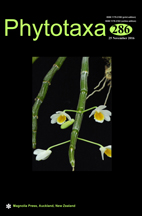Abstract
Six new Pyrenula species are described as new to science, viz. Pyrenula aurantiothallina C. O. Mendonça, Aptroot & M. Cáceres, with orange thallus with KOH+ purple anthraquinone, simple low conical ascomata, inspersed hamathecium, and ascospores 3-septate, 19.5–22.5 × 7–8.5 µm, generally somewhat constricted at the septa; Pyrenula coccinea C. O. Mendonça, Aptroot & M. Cáceres, with yellowish brown thallus and ascomata with 6 to 25 together immersed in a pseudostromata with partly fused outer walls but separate, apical ostioles, covered with red pruina, ascospores 3-septate, 15–18(–20) × 5–6 µm; Pyrenula diamantinensis C. O. Mendonça, Aptroot & M. Cáceres, with thallus yellowish brown, corticate, partly with a layer of whitish pruina, with (often eroded) pseudocyphellae, ascomata flattened to subglobose, numerous, partly covered by a layer of whitish pruina, 0.3–0.5 mm diam., mostly with 2–10 sideways touching but not totally fused, clypeus in upper half much thicker than below, ascospores 3-septate, 26–33 × 11–16 µm, lumina mostly obliquely quadrangular; Pyrenula lilacina C. O. Mendonça, Aptroot & M. Cáceres, with lilac thallus, simple ascomata, and ascospores 3-septate, 31–37 × 11–14 µm; Pyrenula supralaetior C.O. Mendonça, Aptroot & M. Cáceres, which is similar to P. laetior Müll. Arg., but with ascospores 25–31 × 11–13 µm; and Pyrenula violaceastroidea C. O. Mendonça, Aptroot & M. Cáceres, with ascomata pyriform, aggregated by 3–6 perithecia with a shared ostiole but without joint walls (parmentarioid), ostiole, ascomata and thallus partly covered by wine-red to purplish, KOH+ purple, anthraquinone. They were all found by the first author during several recent field trips in the North and Northeast of Brazil.

